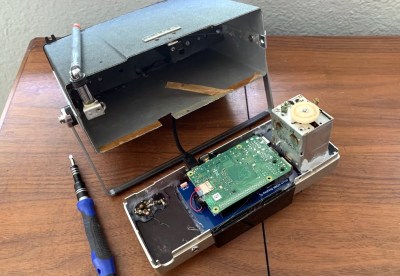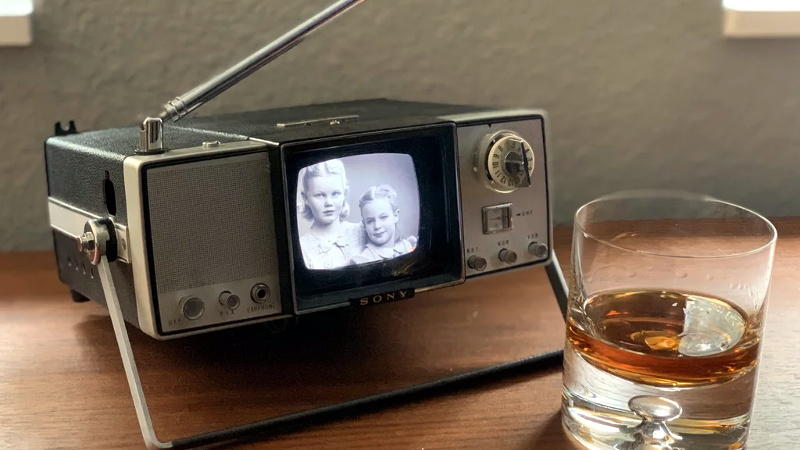Fascinated by the look and feel of vintage electronics, [Democracity] decided to turn an old Sony Micro TV into a digital picture frame that would cycle through old family photos in style. You’d think the modern IPS widescreen display would stick out like a sore thumb, but thanks to the clever application of a 1/16″ black acrylic bezel and the original glass still installed in the front panel, the new hardware blends in exceptionally well.
Driving the new display is a Raspberry Pi 4, which might sound overkill, but considering the front-end is being provided by DAKboard through Chromium, we can understand the desire for some extra horsepower and RAM. If it were us we’d probably have gone with a less powerful board and a few Python scripts, and of course there are a few turn-key open source solutions out there, though we’ll admit that this is probably faster and easier to setup.
 [Democracity] provides some general information on how he took apart the TV and grafted in the new gear, but of course the exact steps will vary a bit depending on which old TV you end up sending to the big parts bin in the sky. We did like that he made sure to keep all the mechanisms for the buttons and knobs intact, so even if they don’t do anything, you can still fiddle around with them.
[Democracity] provides some general information on how he took apart the TV and grafted in the new gear, but of course the exact steps will vary a bit depending on which old TV you end up sending to the big parts bin in the sky. We did like that he made sure to keep all the mechanisms for the buttons and knobs intact, so even if they don’t do anything, you can still fiddle around with them.
Otherwise, his steps for setting up a headless Chromium instance are probably more widely applicable. As are the tips about setting up this particular LCD module and getting the display rotated into the proper orientation. If you just follow along for that part of the guide, you can spin up your own stand-alone Raspberry Pi DAKboard endpoint to take the service for a test drive.
It probably won’t come as much of a surprise to hear that this isn’t the first time [Democracity] has upgraded a piece of vintage hardware. Back in 2017, we covered this gorgeous art deco speaker that he outfitted with RGB LEDs and an Amazon Echo Dot. As with the previous post, it’s likely some commenters will be upset that a vintage piece of gear has been gutted for this project. But we’d counter that by saying his family is going to get a lot more enjoyment out of this beautiful piece of hardware now than they would have if it was still collecting dust in a closet.
















So it’s scrapping the tv set but reusing the case.
So no need to warn about the germanium transistors in there. I was given one about thirty years ago, and there was ripple or unstable sync. But the problem had already veen covered in Mac’s Service Shop (by John T. Frye) in Popular Electronics. A germanium transistor gone bad.
I used that tv set until about 1996, when I replaced it with the Commodore colour monitor I got used with my Amiga 500 (fed by a VCR).
Nice case for an oscilloscope Build.
That’s what brought me here: in the 1980s, Tektronix teamed up with Sony to make some products smaller than their own. Four instruments I know of, the 323, 324, and 326 oscilloscopes, and the 1401A spectrum analyzer, actually DID use this case.
https://www.ebay.com/itm/224526126852
From the article “Perhaps the most difficult part, is finding a combination of vintage television, with their 4:3 aspect ration screen, that will work with modern 16:9 LCD screen. ”
Raspberry PIs are perfectly capable to drive vintage TV sets screens.
I can understand that some of these TVs are difficult to work on especially to find where to inject the composite signal, but an actual CRT aesthetic can’t be simulated well with modern lcd screens.
And classic monochrome video monitors, too.
Here’s a green monitor running with the Composite/CVBS output of a stock Pi:
https://www.youtube.com/watch?v=n54eGmhLgX4
I love the retro feel of old TVs and radios and using it one like this is cool. But I do have to agree that the original CRT look is hard to come by.
I have a Crown portable 5″ CRT TV/Radio and did initially look for a similar TFT/LCD slution, but as it was working I went with converting the RPi output to RF and letting the original kit do it’s job. It plays a random selection of UK and US Civil Defense films from the cold war era.
I did get some way towards getting the CRT feel with an empty Bush DAC90 Radio case and fitting the lens from an old stage spotlight in the speaker hole and having a 10″ screen some distance behind. Not prefect by any means but with the metal speaker grill between the lens and screen the looping Metropolis looks pretty interesting.
Bah – these type of posts have me scouring ebay for more old kit my house isn’t big enough to store :-(
Meh. If you really want to replicate the experience of an old portable TV like this don’t worry about perfecting the CRT look. What you really need is a large battery case that holds lots of expensive D-cells and a big heat sink attached to a bank of resistors that have been sized to drain the life from those batteries in about an hour. Then just throw whatever up for a display, it’s not like you will ever get around to buying a second set of batteries to see it turned on again.
The worst example of this was an add-on battery pack that Sony made for their 9″ portable B&W TV. It gave you about two hours of viewing on a set of D-cell rechargeable alkaline batteries (yes, you read that right), which were good for maybe 20 recharge cycles. I think it cost half as much as the TV.
Yeah, the batteries would be a pain. But whilst it is “portable” I only ever use it mains connected and use the battery compartment to house the RPi.
But just look at how much ROOM there is for batteries! You could run that thing for weeks off of the 18650 Li-ion cells that would fit in there, and it would also weigh about as much as the original TV. Which is a good thing — after all, looking at that thing, you would expect it to weigh at least five pounds, and you might hurt yourself applying the estimated force needed for the apparent weight, and slam it into something at the same time.
Another piece of classic kit gutted. Sigh.
A good way to use CRTs as ‘art’ displays is to rig a PIR module to a relay connected to the sets power. This way the wear to the heater and phosphor is limited to only when someone is in the room. I use this with a weather graph display – something which would quickly ruin a CRT if left on constantly.
thank you for letting me know these things exist. i had planned on turning an old Sony Watchman portable CRT TV into a Raspberry Pi network/weather monitor (not gutting it!), but avoiding burnout is definitely a concern.
Another challenge with the Watchman CRT is that it has no magnetic shielding, and this results in the picture position being altered by the Earth’s magnetic field. Just by rotating the display, it could move as much as half an inch. Consequently, Sony built a LOT of overscan into these. Don’t ask me how i know this.
Yah. It’s hard to watch. But then if nobody ever disposed of or gutted vintage hardware then we’d be swimming in it and it would have no value. Every instance of destruction makes the survivors that much more special.
“Another piece of classic kit gutted. Sigh.”
Nah, don’t be so hard. ;) The tinkerer that did this conversion is one of us, let’s don’t forget that. Comments like this will make her/him very sad and the attitude might kill the hobby in the long run. And the idea alone was worth something. I mean, it’s hard these days to come up with something completely new. Most things had been made in the past years already.
Also, let’s us remember this:
a) That TV could have had ended up in the trash, anyway. Hackers/tinkerers/hams etc are the least which intend to destroy cultural objects. Let’s rather see it as a transformation. Maybe he/she even kept the CRT for further experiments. Also, chassis like this could be 3D printed in worst case. The pictures online alone could help alot re-viving the TV model.
b) The number of people being familiar with tube technology and high voltage is dwindling. We can’t expect the current gen of tinkerers to be familiar with, anymore. Considering this, the current gen is more respectful to ancient technology than we can expect, which is a good thing. In fact, even I myself have to ask my father for tips for such things from time to time, because the tube/rf technology is sometimes so alien to me. It’s a bit like Federation tech vs Klingon tech, hah. ;)
Maybe, in a few years, the current gen will even revive tube technology in a small scale – just as happened with Nixie tubes. Monochrome CRTs, at least, are simple enough to be made my enthusiasts. As long as the youth appreciates us or/and our technology/archivements, the spirit will live on.
Or as an old saying goes: Tradition is not preserving the ashes, but exchanging the fire.
Amen. :)
My idea is that the trip it’s more important than the destination. Using an old TV as a nice case it’s the fastest trip, but trying to using an old TV with new technology is a more rewarding experience because new things are to be learned and a longer an more dangerous trip is a more interesting challenge.
As you say, the number of people that know how a CRT works are dwindling, but because of this more people should try to study old gear.
Looks lika a machine from Myst universe.
+1
I had a small TV like that in the 1980s. Crown Victor or something like that.
I got rid of it, the controls were going bad and the vertical was no longer linear.
Maybe I would’ve kept it knowing that in 40 years I could use its case to make it useful again.